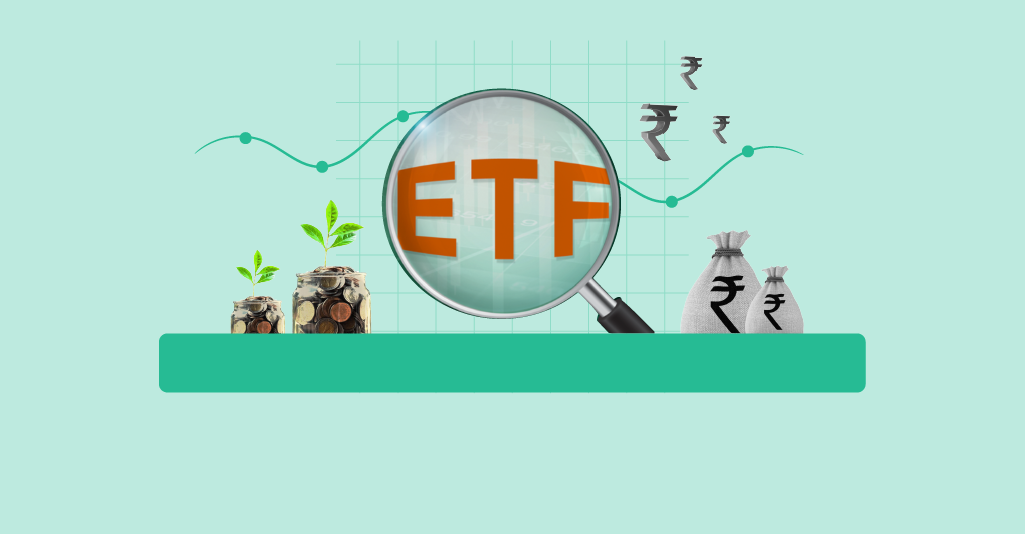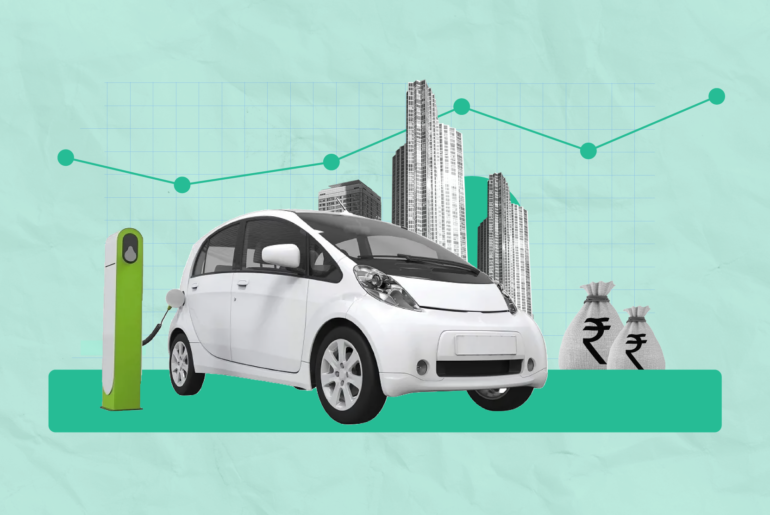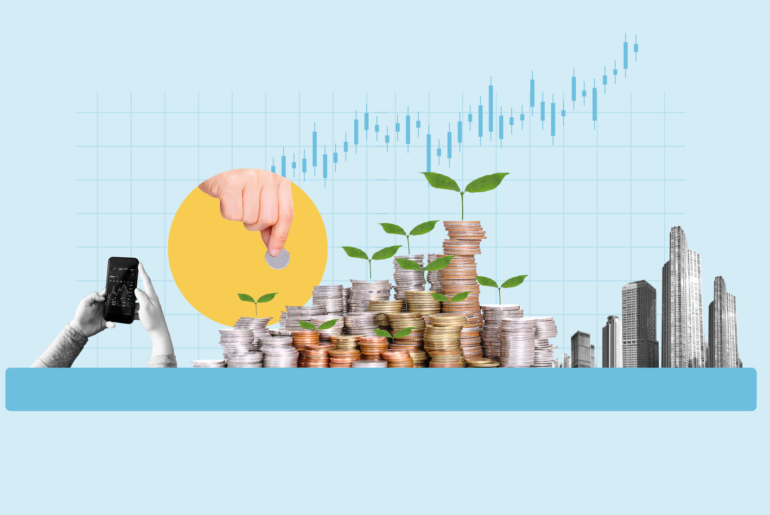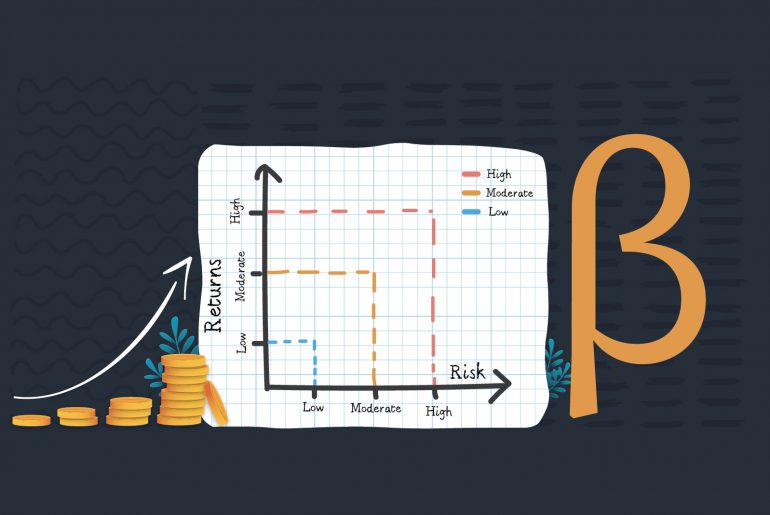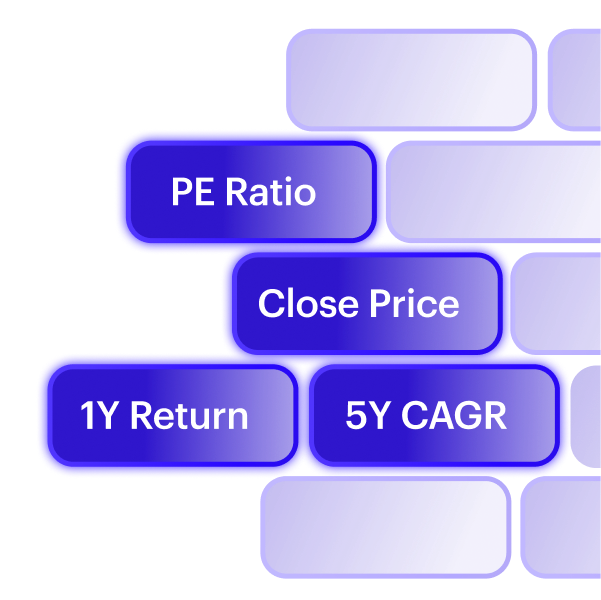Last Updated on Mar 16, 2025 by Nikita Malik
Did you know that the global ETF market reached an impressive $12.71 tn in assets by the end of the first quarter of 2024? This growth highlights the increasing popularity and trust in ETFs among investors worldwide, including in India. ETFs offer a compelling mix of flexibility, cost-effectiveness, and diversified exposure, making them an attractive choice for both new and seasoned investors. But what is an ETF? This article will explore what ETFs are, the best ETFs in India, how to invest in them, their taxation as per the Union Budget 2024-2025, and more!
Table of Contents
Best Gold ETFs in India
| Name | Market Cap (Rs. in cr.) | Close Price (Rs.) | 1Y Return (%) | 5Y CAGR (%) | Expense Ratio (%) |
| IDBI Gold Exchange Traded Fund | 95.12 | 7,134.20 | 27.08 | 14.96 | 0.41 |
| Invesco India Gold Exchange Traded Fund | 74.22 | 6,920.35 | 28.11 | 14.51 | 0.55 |
| Aditya BSL Gold ETF | 353.23 | 69.87 | 27.99 | 14.44 | 0.54 |
| SBI Gold ETF | 2,644.09 | 68.00 | 27.56 | 14.34 | 0.65 |
| ICICI Prudential Gold ETF | 1,905.05 | 68.13 | 27.78 | 14.31 | 0.5 |
| HDFC Gold Exchange Traded Fund | 1,906.09 | 68.02 | 27.64 | 14.31 | 0.59 |
| Axis Gold ETF | 319.17 | 66.24 | 27.65 | 14.30 | 0.55 |
| UTI Gold Exchange Traded Fund | 651.54 | 66.60 | 27.95 | 14.23 | 0.48 |
| Kotak Gold Etf | 1,984.14 | 66.47 | 27.53 | 14.18 | 0.55 |
| Quantum Gold Fund | 130.03 | 65.80 | 27.74 | 14.12 | 0.78 |
Note: The above Gold ETF list NSE is dated 6th November 2024. It is derived from Tickertape’s Stock Screener using the following filters:
- ETFs – Gold
- 1-yr returns
- 5-yr CAGR – Sorted high to low
- Expense ratio
List of Best Equity ETFs In India
| Name | Market Cap (Rs. in cr.) | Close Price (Rs.) | 1Y Return (%) | 5Y CAGR (%) | Expense Ratio (%) |
| CPSE ETF | 23,025.67 | 92.03 | 69.33 | 30.05 | 0.07 |
| Nippon India ETF Nifty Midcap 150 | 373.17 | 214.41 | 39.89 | 28.17 | 0.21 |
| Motilal Oswal Midcap 100 ETF | 77.05 | 59.93 | 41.44 | 27.94 | 0.22 |
| Bharat 22 ETF | 10,739.05 | 113.20 | 49.66 | 25.58 | 0.07 |
| Motilal Oswal NASDAQ 100 ETF | 3,724.73 | 164.42 | 33.87 | 23.43 | 0.58 |
| UTI S&P BSE Sensex Next 50 Exchange Traded Fund | 8.34 | 86.33 | 43.96 | 22.57 | 0.2 |
| ICICI Prudential S&P BSE Midcap Select ETF | 29.29 | 17.69 | 45.56 | 22.42 | 0.15 |
| Nippon India ETF Nifty PSU Bank BeES | 163.46 | 76.54 | 37.69 | 22.32 | 0.49 |
| Nippon India ETF S&P BSE Sensex Next 50 | 20.01 | 84.58 | 43.82 | 22.21 | 0.23 |
| Kotak Nifty PSU Bank ETF | 74.91 | 685.43 | 38.04 | 22.19 | 0.49 |
Note: The above list of top 10 ETF funds in India from the equity category is dated 6th November 2024. It is derived from Tickertape’s Stock Screener using the following filters:
- ETFs – Equity
- 1-yr returns
- 5-yr CAGR – Sorted high to low
- Expense ratio
List of Debt ETFs in India
| Name | Market Cap (Rs. in cr.) | Close Price (Rs.) | 1Y Return (%) | 5Y CAGR (%) | Expense Ratio (%) |
| BHARAT Bond ETF-April 2032 | 6,496.91 | 1,202.70 | 10.47 | 0.0 | |
| LIC MF Nifty 8-13 yr G-Sec ETF | 96.08 | 26.42 | 10.36 | 4.31 | 0.2 |
| Nippon IN ETF Nifty 8-13 yr G-Sec Long Term Gilt | 12.59 | 26.87 | 10.18 | 5.96 | 0.1 |
| BHARAT Bond ETF-April 2031-Growth | 0.00 | 1,277.19 | 9.95 | 0.0 | |
| BHARAT Bond ETF-April 2030-Growth | 6,636.67 | 1,425.70 | 9.64 | 0.0 | |
| SBI Nifty 10 yr Benchmark G-Sec ETF | 28.39 | 239.87 | 9.34 | 4.66 | 0.1 |
| Nippon India ETF Nifty 5 yr Benchmark G-Sec | 31.26 | 58.17 | 9.03 | 0.1 | |
| ICICI Pru Nifty 5 yr Benchmark G-SEC ETF | 22.00 | 58.60 | 8.65 | 0.2 | |
| ICICI Pru Nifty 10 yr Benchmark G-sec ETF | 238.43 | 8.62 | 0.1 | ||
| Mirae Asset Nifty 8-13 yr G-Sec ETF | 27.26 | 8.61 | 0.1 |
Note: The above debt ETF funds list is dated 6th November 2024. It is derived from Tickertape’s Stock Screener using the following filters:
- ETFs – Debt
- 1-yr returns – sorted high to low
- 5-yr CAGR
- Expense ratio
Note that these stocks are in no order of preference. Please note that these stock selection criteria and the stocks are provided for informational purposes only; it is essential to conduct your own research.
What Are ETFs?
The ETF full form is Exchange Traded Funds. ETFs are investment funds that are traded on stock exchanges, similar to stocks. ETFs pool money from investors to buy a diversified portfolio of assets, including stocks, bonds, or commodities. They are designed to track the performance of a specific index, such as the Nifty 50, providing you with an opportunity to invest in a broad market segment through a single fund. ETFs are gaining popularity among Indian investors due to their low expense ratios, liquidity, and potential for diversification.
When you invest in an ETF, you essentially own a share of the fund’s portfolio. This structure allows you to gain exposure to a wide range of assets without having to buy each one individually. For example, a Nifty 50 ETF will replicate the performance of the Nifty 50 index, which comprises 50 of the largest and most liquid companies listed on the National Stock Exchange (NSE) of India.
Things to know about ETFs
- There are several costs associated with ETFs expressed as the expense ratio. These include the fund manager’s fees to run the ETF, compliance, distribution fees, etc. These expenses are adjusted with your ETF’s returns, lowering the returns. So consider your investment expenses when investing in an ETF.
- ETFs listed on a stock exchange are subject to price fluctuations. The profit you earn from an ETF depends on the stock market conditions.
- ETFs are moderately diversified. Since even the best ETFs are passively managed, they usually invest in top-performing listed stocks.
- Look for ETFs that provide adequate liquidity so you can exit when you want to. There are two things to look at – the liquidity of underlying stocks and the liquidity of the fund itself.
Types of ETFs
In India, there are several types of ETFs available, catering to different investment needs and preferences. Here are some of the most common types of ETFs you might consider:
- Equity ETFs: These ETFs invest in stocks and aim to replicate the performance of a specific equity index. The most popular equity ETFs in India track indices such as the Nifty 50, Sensex, and Nifty Next 50.
- Debt ETFs: These funds invest in fixed-income securities like government bonds, corporate bonds, and other debt instruments. Debt ETFs can be a good option if you are looking for a stable income with lower risk compared to equity ETFs.
- Gold ETFs: These ETFs invest in physical gold and aim to track the price of gold. Gold ETFs provide a convenient way for you to invest in gold without having to worry about the storage and security issues associated with physical gold.
- International ETFs: These funds invest in foreign markets, allowing you to diversify your portfolio globally. International ETFs can be based on indices from various countries or regions.
- Sector and Thematic ETFs: These ETFs focus on specific sectors or themes, such as technology, banking, or energy. Investing in sector or thematic ETFs allows you to capitalise on growth trends within particular industries.
How to Invest in ETF in India?
Investing in ETFs (Exchange Traded Funds) in India can be a straightforward process if you follow the necessary steps. ETFs offer you a diversified portfolio with the flexibility of trading like stocks. Here’s a detailed guide on how you can invest in ETFs:
Step-by-Step Guide to Investing in ETFs
- Open a Demat and Trading Account:
To invest in ETFs, you need a Demat (Dematerialised) account and a trading account. These accounts can be opened with any SEBI-registered stock broker in India. The Demat account will hold your ETF units in electronic form, while the trading account will enable you to buy and sell ETFs on the stock exchange. - Choose the Right ETF:
Selecting the right ETF is crucial. You should consider factors such as the ETF’s underlying index, expense ratio, historical performance, and liquidity. If you are looking for broad market exposure, a Nifty 50 ETF might be a good option. For sector-specific exposure, you could consider sector or thematic ETFs. - Research and Analysis:
Utilise online platforms like Tickertape to research and analyse different ETFs. Tickertape Stock Screener lets you filter ETFs based on various criteria such as market capitalisation, revenue growth, and profitability. This can help you make an informed decision based on your investment goals and risk tolerance. - Place an Order:
Once you have chosen the ETF you want to invest in, you can place a buy order through your trading account. You need to specify the ETF name or symbol (e.g., Nifty 50 ETF), the number of units you wish to purchase, and the price at which you want to buy. You can place either a market order (buying at the current market price) or a limit order (buying at a specified price). - Monitor Your Investment:
After purchasing ETFs, it’s important to regularly monitor your investment. You can track the performance of your ETFs using your brokerage platform or financial websites. Monitoring helps you stay updated on market trends and make timely decisions if needed. - Rebalance Your Portfolio:
Periodically reviewing and rebalancing your portfolio is essential to ensure it aligns with your investment objectives. If your ETF holdings have deviated from your desired asset allocation, you might need to buy or sell certain ETFs to maintain the balance.
Taxation of ETFs as per Union Budget 2024-2025
The Union Budget 2024-2025 introduced notable changes to the taxation of Exchange-Traded Funds (ETFs) in India, particularly regarding capital gains and tax exemptions for certain funds.
Key Tax Changes for ETFs
Capital Gains Tax Rates:
- Short-Term Capital Gains (STCG): Gains from the sale of ETFs held for less than 24 months will be taxed at 20%.
- Long-Term Capital Gains (LTCG): Gains from ETFs held for more than 24 months will be taxed at 12.5%, without the benefit of indexation. This aligns ETFs with the treatment of other long-term investments.
Tax Exemptions for ETFs in IFSC:
- ETFs set up in the International Financial Services Centre (IFSC) Gift City will enjoy tax exemptions similar to those available to Category III Alternative Investment Funds (AIFs). This includes a concessional tax rate of 10% on interest and dividend income, along with capital gains tax exemptions on various securities (excluding shares in Indian companies). This change aims to promote investment in the IFSC and enhance its attractiveness as a financial hub.
Definition Changes for Specified Mutual Funds:
- The budget revised the definition of specified mutual funds. Now, any fund investing more than 65% of its total proceeds in debt instruments will be classified as a specified mutual fund, which will be taxed according to the investor’s income tax slab. This change helps clarify the tax treatment for ETFs and similar funds, which were previously subject to ambiguity due to their investment structures.
Investors should be aware of the new holding periods and tax rates to optimise their investment strategies effectively. The introduction of tax exemptions for ETFs in the IFSC also opens up new opportunities for investors looking to benefit from favourable tax conditions.
Benefits of Investing in ETFs
Diversification
ETFs offer instant diversification by investing in a broad range of assets, such as stocks, bonds, or commodities. This can help you reduce the risk associated with individual investments.
Cost-Effectiveness
ETFs generally have lower expense ratios compared to mutual funds, making them a cost-effective investment option. Lower costs can lead to higher net returns over time.
Liquidity
ETFs are traded on stock exchanges, providing high liquidity. You can buy and sell ETF units at market prices throughout the trading day, similar to stocks.
Transparency
ETFs are required to disclose their holdings regularly. This transparency allows you to know exactly what assets are included in the ETF, helping you make informed investment decisions.
Flexibility
ETFs offer flexibility in trading. You can use various trading strategies, such as stop-loss orders or margin trading, to manage your investments more effectively.
Risks Associated with ETF Investments
Market Risk
Like all investments in the stock market, ETFs are subject to market risk. The value of even the best ETF in India can fluctuate based on market conditions and the performance of the underlying assets.
Tracking Error
ETFs aim to replicate the performance of a specific index, but there can be a discrepancy between the ETF’s returns and the index returns, known as tracking error. Factors contributing to tracking error include management fees, cash holdings, and transaction costs and can affect even the top ETF in India.
Liquidity Risk
While most ETFs are highly liquid, some ETFs, especially those focusing on niche markets or sectors, might have lower trading volumes. This can lead to wider bid-ask spreads and difficulty in executing large trades.
Tax Implications
As discussed, the tax treatment of even the top 5 ETF in India can be complex, and you need to consider the tax implications of your investments. Short-term and long-term capital gains are taxed differently, and dividends are added to your income and taxed at your applicable slab rate.
Management Risk
ETFs are managed by fund managers who make decisions on asset allocation. The performance of even the best ETF for long term can be influenced by the manager’s decisions and strategies.
How to Identify the Best ETF In India?
Identifying the best ETF to invest in involves careful analysis and consideration of several key factors. Whether you are new to investing or looking to optimise your portfolio, understanding these aspects can help you make more informed decisions.
Using Tickertape Stock Screener
Utilising Tickertape Stock Screener can further refine your ETF selection process. Tickertape allows you to filter and compare ETFs based on various criteria, including performance, expense ratios, liquidity, and more. You can also generate various lists based on these criteria, including an NSE ETF list with volume. Check it out now!
Expense Ratio
One of the most critical factors to consider when identifying the top 10 ETF funds in India for long term is the expense ratio, which represents the annual fee that all ETF shareholders pay. A lower expense ratio can significantly impact your overall returns over time. When comparing the top 10 ETF in India, you can look for those with the lowest expense ratios that still meet your investment goals. For example, if you are evaluating the best Nifty 50 ETF, comparing their expense ratios can help you identify the most cost-effective option.
Performance History
Reviewing an ETF’s historical performance can provide insights into how well the fund has performed over different market conditions. While past performance is not a guarantee of future results, it can help you understand the fund’s volatility and consistency in delivering returns.
Underlying Index
ETFs typically track a specific index. Understanding the index an ETF tracks can give you a clearer picture of the sectors or asset classes you are investing in. For instance, a Nifty ETF in the Nifty 50 ETF list tracks the Nifty 50 index, which includes the top 50 companies listed on the NSE. Knowing the index helps ensure that the ETF aligns with your investment strategy and risk tolerance.
Liquidity
Liquidity is essential as it affects how easily you can buy or sell shares of the ETF without significantly impacting its price. High liquidity generally means tighter bid-ask spreads, reducing the cost of trading. Checking the trading volume and bid-ask spread of ETFs can help you assess their liquidity. The NSE ETF list can provide insights into the liquidity of various ETFs available in India.
Diversification
Evaluate the level of diversification the ETF offers. A well-diversified ETF can reduce risk by spreading investments across multiple assets or sectors. If you want to consider the best ETF to invest in India, you can consider how diversified the underlying holdings are and whether they align with your risk appetite and investment goals.
Tax Efficiency
Tax considerations are crucial. Understanding the tax treatment of dividends and capital gains for ETFs can help you optimise your after-tax returns. For instance, ETFs that offer better tax efficiency can be more advantageous for long-term investments.
Management Style
ETFs can be either passively managed (tracking an index) or actively managed (where managers make decisions about the fund’s investments). Passive ETFs in the NSE India ETF list typically have lower expense ratios compared to active ETFs. Understanding the management style can help you decide which ETF aligns with your investment philosophy.
By considering these factors, you can better identify the best ETFs to invest in and enhance your investment portfolio. Whether you are exploring the best ETFs to invest in, looking at the list of ETFs in India, or focusing on specific sectors with ETF funds, thorough research and understanding of these aspects are crucial for making informed investment decisions.
Strategies for Investing in ETFs
Diversification
One effective strategy for investing in ETFs is diversification. You can spread your investments across various sectors and asset classes. For instance, you can invest in a mix of equity ETFs, debt ETFs, and commodity ETFs like gold ETFs. Diversifying helps you balance the potential volatility of equities with the stability of bonds and the inflation hedge offered by gold.
Dollar-Cost Averaging
Another strategy for investing in the top ETF funds in India is dollar-cost averaging. This involves investing a fixed amount of money at regular intervals, regardless of the ETF’s price. This approach can help you avoid the pitfalls of market timing and reduce the impact of volatility over time. By consistently investing, you average out the purchase price of the ETF units, potentially lowering your overall cost.
Sector and Thematic Investing
You might also consider focusing on specific sectors or themes that have strong growth potential. Sector ETFs allow you to target particular industries, such as technology or healthcare, while thematic ETFs focus on broader investment themes like clean energy or artificial intelligence. This strategy can help you capitalise on trends and innovations within specific areas.
Rebalancing
Regularly rebalancing your ETF portfolio ensures that it remains aligned with your investment goals and risk tolerance. Market fluctuations can cause your asset allocation to drift from your desired mix. Rebalancing involves selling overperforming ETFs and buying underperforming ones to maintain your target allocation.
Future Trends in the ETF Market
Below mentioned are a few potential trends of the ETF market.
Growth of Passive Investing
Passive investing through ETFs is expected to continue its growth trajectory. Investors are increasingly drawn to the low-cost, transparent, and diversified nature of ETFs. The trend towards passive management, where ETFs track specific indices rather than attempting to outperform the market, is likely to dominate the investment landscape.
ESG and Thematic ETFs
Environmental, Social, and Governance (ESG) investing is gaining traction. More investors are seeking funds that align with their values and sustainability goals. Thematic ETFs focusing on ESG criteria, clean energy, technology, and other innovative sectors are expected to grow in popularity as investors look for ways to invest in line with their beliefs.
Technological Advancements
Advancements in technology are making ETFs more accessible and easier to trade. Online platforms and robo-advisors are simplifying the investment process, allowing more investors to participate in the ETF market. Additionally, technology is enhancing the transparency and efficiency of ETF operations.
Regulatory Developments
Regulatory changes can significantly impact the ETF market. In India, regulatory bodies like SEBI continue to refine guidelines to ensure investor protection and market integrity. Staying informed about regulatory developments is crucial for understanding potential shifts in the ETF landscape.
Comparison of Popular ETFs
Nifty 50 ETFs
Nifty 50 ETFs, such as the iShares India 50 ETF (INDY), track the performance of the Nifty 50 Index, comprising 50 of the largest Indian companies. These ETFs offer broad market exposure and may be suitable for you if you are seeking to invest in the overall growth of the Indian economy.
Gold ETFs
Gold ETFs, like the Nippon India Gold ETF, provide exposure to physical gold prices without the need to own or store physical gold. These ETFs could be a good option for you if you are looking to hedge against inflation and economic uncertainty.
Debt ETFs
Debt ETFs, such as the Bharat Bond ETF, invest in government or corporate bonds. These ETFs offer a stable income with lower risk compared to equity ETFs. They are ideal if you are a conservative investor looking for steady returns.
Understanding ETF Expenses and Fees
When investing in Exchange-Traded Funds (ETFs), it’s essential to understand the various expenses and fees that can affect your overall returns. Here is a detailed look at the main types of costs associated with ETFs:
Expense Ratios
The expense ratio is the primary cost for owning an ETF. It is an annual fee expressed as a percentage of the fund’s average net assets. This fee covers management fees, administrative costs, and other operational expenses. For example, if an ETF has an expense ratio of 0.75%, you would pay Rs. 7.50 annually for every Rs. 1,000 invested. Over time, these fees can significantly impact your investment returns.
Transaction Costs
ETFs are traded on stock exchanges, similar to individual stocks. As a result, investors incur transaction costs each time they buy or sell shares. These costs include:
- Brokerage Commissions: Fees paid to brokers for executing trades. Some brokers offer commission-free ETFs, but this depends on the brokerage firm and the specific ETFs.
- Bid-Ask Spread: The difference between the buying (ask) price and the selling (bid) price. A wider spread can increase your transaction costs, particularly for ETFs with lower trading volumes.
Management Fees
Management fees are part of the expense ratio and compensate the fund managers for their services. Actively managed ETFs, which involve more frequent buying and selling of assets to outperform a specific index, typically have higher management fees than passively managed ETFs, which simply track an index. Understanding the management style of the ETF can help you gauge these costs better.
Marketing Fees
Marketing fees, often referred to as 12b-1 fees in the context of mutual funds, are used to cover the costs of promoting and distributing both the mutual funds and ETFs. While not all ETFs charge these fees, they are included in the overall expense ratio for those that do. These fees are indirectly paid by the investors, as they are deducted from the fund’s assets.
Additional Costs
Other potential fees associated with ETFs include:
- Custody Fees: Costs for holding the ETF’s assets.
- Legal and Accounting Fees: Expenses related to regulatory compliance and financial reporting.
- Trading Costs: Fees incurred when the ETF buys or sells the underlying assets.
These costs are typically less transparent but can still affect the overall cost of your investment. It’s important to review the ETF’s prospectus and other financial documents to understand all the associated costs.
How Fees Are Deducted
ETF fees are deducted from the fund’s assets rather than being paid directly by investors. This means the fees are taken from the returns generated by the ETF. For instance, if an ETF has a total return of 5% for the year and an expense ratio of 0.5%, your net return would be 4.5% after fees.
Common Mistakes to Avoid When Investing in ETFs
Ignoring the Expense Ratio
A common mistake investors make is overlooking the expense ratio. Even a small difference in expense ratios can have a significant impact on long-term returns. Always compare the expense ratios of similar ETFs to ensure you are minimising costs.
Not Considering Liquidity
Liquidity refers to how easily you can buy or sell ETF shares without significantly affecting their price. Low liquidity can lead to higher bid-ask spreads, increasing your transaction costs. Always check the trading volume of an ETF before investing to ensure sufficient liquidity.
Overlooking Diversification
While ETFs generally offer diversified exposure, some may be heavily concentrated in specific sectors or regions. Ensure that the ETF aligns with your overall investment strategy and provides adequate diversification to manage risk effectively.
Ignoring Tax Implications
Although ETFs are typically more tax-efficient than mutual funds, they can still generate taxable capital gains distributions. Be aware of the tax implications of buying and selling ETFs, especially if you are investing in a taxable account.
Chasing Performance
Avoid selecting ETFs solely based on their past performance. Historical performance does not guarantee future results. Consider other factors such as the expense ratio, management style, and how the ETF fits into your overall investment strategy.
To Conclude
ETFs present a versatile and efficient way to invest in the Indian market, offering broad exposure to various assets with relatively low costs. When evaluating the best ETFs to invest in India, it is essential to consider factors such as expense ratios, underlying assets, and historical performance. By carefully selecting ETFs that align with your investment strategy, you can achieve your financial objectives more effectively.
Whether you are interested in the best Nifty 50 ETFs, exploring the comprehensive NSE ETF list, or targeting the best ETFs to invest in, thorough research and a clear understanding of these financial instruments can significantly enhance your investment portfolio. Remember, while ETFs simplify the investment process, aligning them with your overall strategy and financial goals is key to maximising returns. With the right knowledge and approach, ETFs can be a powerful addition to your investment toolkit.
Frequently Asked Questions (FAQs) About ETFs
1. Which is the best ETF to buy in India?
You can find top ETFs in India on Tickertape. Here’s how:
-Launch Tickertape’s Stock Screener
-Go to ETF under the ‘Sector’
-Select the sub-category – gold, equity, and debt
-Add other desired filters such as returns, expense ratio, etc to generate different list of ETF in India.
2. Is it good to invest in ETF in India?
ETFs are gaining more popularity by the day. Investing in ETFs has several benefits, such as liquidity, low cost, transparency, and so on. Learn more about these assets before investing in them.
3. What are the types of ETFs?
-Gold ETF
-Debt ETF
-Liquid ETF
-Equity ETF
-Commodity ETF
-ETF fund of funds
4. Do I need a Demat account to trade ETFs?
Yes. You will need a Demat account to buy and sell ETFs. The Demat account holds your ETFs electronically, making trading seamless and secure.
5. How long can I hold an ETF?
You can stay invested in an ETF for as long as you wish. ETFs have no lock-in period. This flexibility can allow you to align your investment with your long-term financial goals.
6. Do ETFs pay dividends?
Yes. An ETF pays dividends as it holds multiple stocks in its portfolio. These dividends are usually paid out quarterly and reflect the income generated from the underlying assets.
- List of High Beta Stocks in India: Volatile Shares on NSE - Apr 11, 2025
- Top Large Cap Funds 2025: Discover Blue Chip Performers - Mar 27, 2025
- Gilt Funds in India: Features, Meaning, and Advantages - Mar 13, 2025
